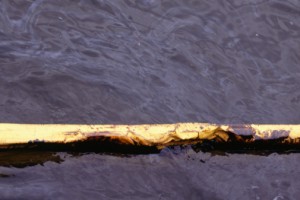Looking Back at the Gulf Horizon Spill

Photo: Paul Katz
It’s been almost a year since the Deepwater Horizon spill in the Gulf of Mexico, and more data is available on the magnitude of the spill. In a recent article, The New York Times describes the spill’s size as “some 4.9 million barrels of oil.” That led me to two numerical musings.
First, I wanted to make the number meaningful by comparing it to another large, famous spill: the Exxon Valdez. Its size is imprinted in my memory as 11 million gallons, which is about 250,000 barrels. So the Deepwater spill was about 20 times larger than the Valdez. In retrospect, that makes sense. The Deepwater well reached into a geologic formation. Whereas the Valdez was merely what one could take from another formation and stuff even into a big ship.
Second, I wanted to estimate the daily spill rate and compare it to the contemporaneous quoted values, not least because in a Q&A on this blog, I was asked about the size of the spill. I didn’t claim any special knowledge but did worry about how the numbers were being reported:
Several early news news reports…reported a flow estimate of 5000 barrels per day. However, other contemporaneous reports quoted the flow as 210,000 gallons per day. Because a barrel (of oil) is 42 gallons, the two numbers are numerically equivalent. However, they are psychologically different. The gallons-per-day figure of 210,000 includes a second nonzero digit (the “1” in the “21”), implying that it is based on quite accurate measurements. The number 210,000 suggests an accuracy of a few percent. In contrast, the 5000 (for barrels per day) suggests merely that the “5” is somewhat reliable but promises little more. The suggested accuracy is perhaps 20 percent—a much more plausible conclusion, especially as some current flow estimates range up to 50,000 barrels per day.
Time to use the current figures to make a current estimate of the spill rate. To do so, I need to estimate how long the well leaked. I could look it up with a web search, but it’s a fun sport to see how much one can get from just the article (desert-island estimation). It says that “samples were taken” starting on July 27, “just weeks after the wellhead was capped.” I’ll therefore guess that it was capped on July 6. The spill started on April 20, so it lasted about 2.5 months or 75 days. With roughly 5 million barrels spread over 75 days, the rate is roughly 60,000 barrels per day. Thus, the “5” in the early news-report estimates of 5000 per day was hardly “somewhat reliable” (what I had written)—it was totally fiction.

Comments